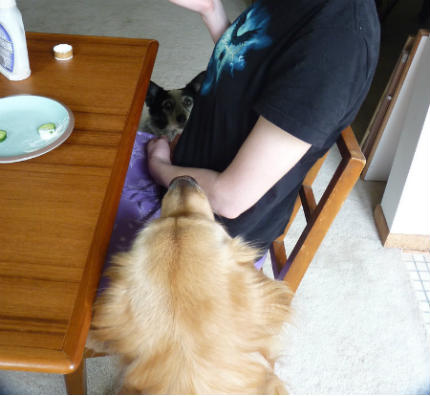Our pets are an important part of the family and that is why we always try to ensure their well-being. We take care of their diet, hygiene, illnesses and, in general, all aspects that allow them to maintain a healthy life. To contribute to the care you give your pet, today we will talk about
gastric torsion in dogs : its causes, its symptoms and some recommendations, since it is a disease that can be potentially fatal if not treated immediately. It is always important to offer a good diet, in this case it is advisable to use feed with a lot of digestibility from the Super Premium range. Since it is more digestible, the daily ration will be lower and it will be better fed. In breeds that are very prone or have this pathology, it is recommended to give them the ration. daily divided into two doses, at Lobo Azul feed we have Super Premium Lamb Feed available that gives very good results in dogs with delicate stomachs.

What is gastric torsion?
Gastric torsion, whose full name is
gastric dilation-torsion syndrome , is an acute disease that occurs in many groups of animals, including humans. In dogs, the
breeds most likely to suffer from gastric torsion are large, deep-chested,
boxer -type, Great Dane,
German Shepherd , Giant Schnauzer,
Doberman , Bulldog,
Dalmatian , among others, although smaller breeds can also suffer from it. if they are not provided with adequate nutrition.
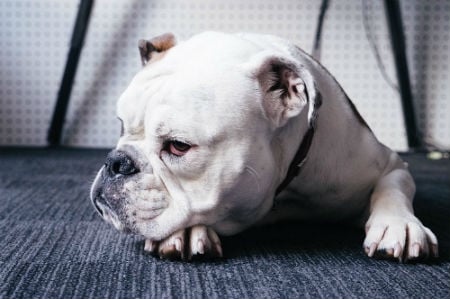
What happens during gastric torsion in dogs?
Gastric torsion in dogs is caused by the accumulation of gases in the stomach and the inability of the body's own physiological mechanisms to empty them. This accumulation
causes the dilation of the stomach walls and their rotation or twisting on their longitudinal axis, causing in turn the strangulation of the veins and arteries that supply it, hypovolemic shock – or reduction in the amount of blood circulating through the stomach. body‒ and severe ischemia‒or decreased blood flow‒ of the walls of the stomach. Sometimes,
more or less pronounced torsion of the spleen may also occur due to the pressure exerted by the stomach and also torsion or
strangulation of the intestine , which is known as
volvulus . The entire picture of difficulty in blood flow, plus the accumulation of substances that mediate inflammation, causes cardiac arrhythmias and severe poisoning in the dog. In addition to the inability to empty the stomach due to the torsion it suffers.

Causes of gastric torsion in dogs: some hypotheses
The exact
causes of gastric torsion in dogs are not known. One of the proposed hypotheses is the inability of the ligaments that support the stomach to adequately support it due to the great dilation it suffers from the accumulation of gases. However, it is believed that
it may also be related to some abnormality in the movements of the stomach and may even have some hereditary component. Its appearance has been associated with copious food intake in one sitting, as well as eating very quickly, drinking a large amount of water, and eating immediately before or after performing physical exercise. The development of stressful situations for the dog during mealtime has also been mentioned.
Symptoms of gastric torsion in dogs
Initial symptoms
The first symptom that may appear is
inflammation or swelling of the stomach , which should draw your attention and be a reason for careful observation of the dog, as it can progress rapidly until gastric torsion occurs. Given these first symptoms, it is important to take appropriate precautions, which may include a visit to the veterinarian, since early detection will allow for adequate and timely treatment that can save your dog's life.
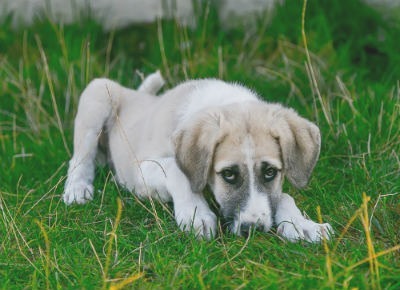
Associated symptoms
In addition to inflammation or swelling,
your dog may begin to present other symptoms associated with the internal process that is developing:
- Produces a lot of gas or belching.
- He appears restless and complains.
- He suffers from abdominal spasms that cause nausea and the desire to vomit, but he is unable to do so; spit foamy saliva.
- The abdominal cavity sounds like a drum if you tap it gently.
- You may have difficulty breathing .
- You will see that something is happening because he will be depressed, weak and without appetite.
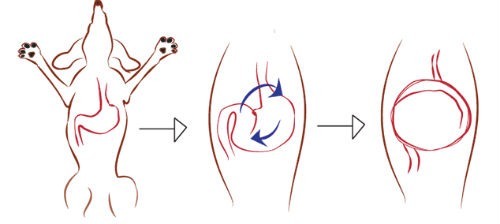
Treatment of gastric torsion in dogs
Initial treatment
The main treatment is
immediate attention to your dog by the veterinarian who will proceed with the diagnosis, for which he can help with an x-ray that will allow him to see how distended the stomach is. As soon as possible, you should stabilize him by giving intravenous fluids and antibiotics and, if possible, emptying the stomach to reduce the pressure. Once stabilization of the dog's general condition is achieved and depending on the severity of the torsion, surgical intervention may be necessary to
return the stomach and spleen to their natural position and remove the parts of the intestine that have suffered necrosis. . Sometimes the stomach must be connected directly to the colon to avoid future episodes of torsion and must be fixed to the costal wall to avoid the risk of future torsion.
Postoperative treatment
In addition to all the care that must be followed in emergency treatment and possible surgical intervention, you must be especially careful with subsequent treatment due to the risks of infection that may arise that could lead to peritonitis. However, one of the greatest
postoperative complications can occur due to the resumption of blood supply to the affected tissues. When normal blood circulation is restored, cardiac arrhythmias may occur that must be treated with the indicated drugs.
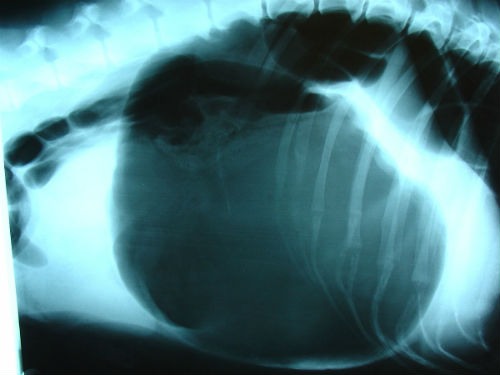
recommendations
To
prevent your dog from suffering gastric torsion , the main recommendation is to control the amount of food consumed at each meal. It is preferable that you divide his meals and establish a more or less fixed schedule for him to eat them. It is also recommended to control water intake after each meal and avoid exercise one hour before and at least three hours after eating. Also help him by maintaining a relaxed atmosphere when he eats. Remember that these preventive measures will not necessarily prevent your dog from suffering from gastric torsion, so you should always be aware of its condition and immediately go to the veterinarian in case of any suspicion. [embed]https://www.youtube.com/watch?v=KaxbF4u-JRg[/embed]







